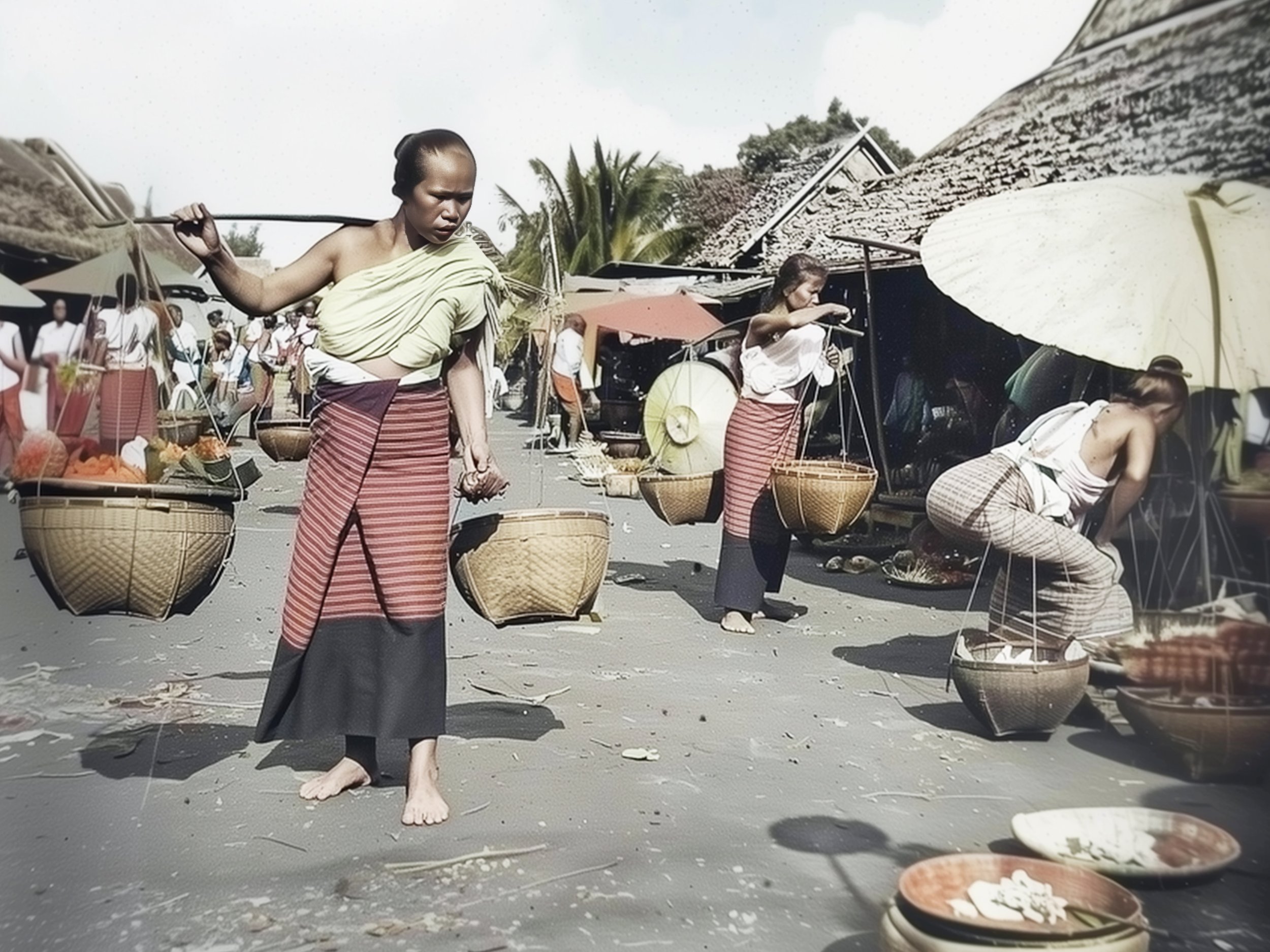แฟชั่นของสตรีเชียงใหม่ในศตวรรษที่ 19: แรงบันดาลใจจากภาพถ่ายของหลวงอนุสารสุนทรกิจ
แฟชั่นของสตรีเชียงใหม่ในศตวรรษที่ 19: แรงบันดาลใจจากภาพถ่ายของหลวงอนุสารสุนทรกิจ
คอลเลกชันภาพที่ได้รับการปรับแต่งโดย AI นี้ ได้รับแรงบันดาลใจจากภาพถ่ายต้นฉบับของ หลวงอนุสารสุนทรกิจ (พ.ศ. 2410–2477 / ค.ศ. 1867–1934)
ช่างภาพอาชีพคนแรกของเชียงใหม่ ผู้บันทึกภาพวิถีชีวิตและแฟชั่นของสตรีล้านนาในอดีต
หลวงอนุสารสุนทรกิจเป็นพ่อค้าที่มีบทบาทสำคัญในเส้นทางการค้าของล้านนาในช่วงปลายศตวรรษที่ 19 และต้นศตวรรษที่ 20 ท่านได้รับการถ่ายทอดความรู้ด้านการถ่ายภาพจาก พระยาเจริญราชไมตรี (จำนง อมาตยกุล) ซึ่งเป็นข้าราชการในเชียงใหม่และมีความเชี่ยวชาญด้านการถ่ายภาพ
ภาพถ่ายของท่านบันทึกวิถีชีวิตของชาวเชียงใหม่ ตั้งแต่ตลาดท้องถิ่น ไปจนถึงพิธีกรรมทางศาสนา แสดงให้เห็นถึงการเปลี่ยนแปลงของสังคมล้านนาในช่วงที่เริ่มรับอิทธิพลจากสยาม อังกฤษ และพม่า
หนึ่งในหัวข้อสำคัญที่ปรากฏในภาพถ่ายของหลวงอนุสารสุนทรกิจ คือ เครื่องแต่งกายของสตรีเชียงใหม่ ซึ่งสะท้อนถึงเอกลักษณ์ของวัฒนธรรมล้านนา และวิวัฒนาการของเครื่องแต่งกายในช่วงเวลาดังกล่าว
เครื่องแต่งกายสตรีเชียงใหม่: ซิ่นต๋า เอกลักษณ์ของผ้าซิ่นล้านนา
ในศตวรรษที่ 19 สตรีเชียงใหม่ส่วนใหญ่นิยมแต่งกายด้วย ซิ่น และ ผ้าสไบ ที่ใช้พันหรือคล้องไหล่ ผ้าซิ่นที่ได้รับความนิยมมากที่สุด คือ ซิ่นต๋า (หรือ ซิ่นตา / ซิ่นต่อตีนต่อเอว) ซึ่งเป็นเอกลักษณ์ของเชียงใหม่
ลักษณะเด่นของซิ่นต๋า
โครงสร้างและลวดลาย
ซิ่นต๋า เป็นซิ่นล้านนาแบบดั้งเดิมที่ทอด้วย ฝ้าย หรือ ไหม
โดดเด่นด้วย ลายทางแนวนอน บริเวณกลางตัวซิ่น ซึ่งเกิดจากเทคนิคการทอที่ใช้ด้ายยืนสลับสี
ซิ่นชนิดนี้ ไม่มีลวดลายซับซ้อน เหมือนซิ่นจกที่มีลวดลายประณีต เหมาะกับการใช้งานในชีวิตประจำวัน
โครงสร้างของซิ่น
ซิ่นต๋าเป็น ผ้าท่อเย็บติดกันเพียงด้านเดียว ทำให้มีลักษณะเป็นทรงกระบอก
ตัวซิ่นจะมีความยาวไม่มากนัก จึงต้อง ต่อชาย (ตีน) และต่อเอว ด้วยผ้าสีพื้น เช่น สีแดง สีดำ หรือสีน้ำตาล
ความสมดุลของสัดส่วน
การต่อเอวและต่อชายทำให้เกิดความสมดุลของเครื่องแต่งกาย ช่วยให้รูปร่างของผู้สวมใส่ดูมีเอวและสะโพกชัดเจนขึ้น
ซิ่นต๋ามีความเรียบง่าย เหมาะสำหรับใช้งานทุกโอกาส
ซิ่นต๋าในโอกาสพิเศษ
ในโอกาสที่เป็นทางการ สตรีชั้นสูงมักสวม ซิ่นต๋าที่ทอด้วยไหม
บางคนจะต่อ ตีนจก ที่ชายซิ่นเพื่อเพิ่มความหรูหรา เช่น ซิ่นตีนจกแม่แจ่ม ซึ่งเป็นลวดลายที่มีชื่อเสียง
การแต่งกายส่วนบนของสตรีเชียงใหม่
ในช่วงศตวรรษที่ 19 สตรีเชียงใหม่ยังคงนิยม ใช้ผ้าพันตัวแทนเสื้อ แตกต่างจากสตรีในกรุงเทพฯ ที่เริ่มนิยมสวมเสื้อแขนยาว
ผ้าสไบ เป็นเครื่องแต่งกายหลักของสตรีล้านนา ใช้พันรอบอกหรือพาดไหล่
ในฤดูหนาวหรือโอกาสพิเศษ สตรีบางคนอาจสวม เสื้อแขนยาวแบบผ่าอก ที่ได้รับอิทธิพลจากพม่าและจีน
สำหรับสตรีชั้นสูง ผ้าสไบที่ใช้มักเป็นผ้าไหมปักลวดลายหรือมีดิ้นทอง ขณะที่ชนชั้นทั่วไปมักใช้ ผ้าฝ้ายเนื้อบางเบา
คุณค่าทางวัฒนธรรมและประวัติศาสตร์ของซิ่นต๋า
ซิ่นต๋า ไม่ได้เป็นเพียงแค่ผ้านุ่งของหญิงล้านนา แต่ยังเป็น สัญลักษณ์ของภูมิปัญญาการทอผ้า และอัตลักษณ์ของเชียงใหม่ ผ้าซิ่นชนิดนี้สามารถพบเห็นได้ในกลุ่มชนทุกชนชั้น ไม่ว่าจะเป็น แม่ค้าในตลาด ช่างฝีมือ หรือสตรีชนชั้นสูง โดยวัสดุและลวดลายจะเป็นตัวกำหนดสถานะของผู้สวมใส่ ในช่วงปลายศตวรรษที่ 19 เมื่อเชียงใหม่เริ่มรวมเข้าเป็นส่วนหนึ่งของสยาม แฟชั่นการแต่งกายเริ่มเปลี่ยนแปลง อย่างไรก็ตาม ซิ่นต๋า ยังคงเป็นที่นิยมและกลายเป็นสัญลักษณ์ของวัฒนธรรมล้านนาจนถึงปัจจุบัน
ภาพที่ได้รับการปรับแต่งโดย AI ในคอลเลกชันนี้ ถือเป็นการย้อนรำลึกถึงผลงานของ หลวงอนุสารสุนทรกิจ ที่บันทึกแฟชั่นและวิถีชีวิตของหญิงเชียงใหม่ในอดีต การรังสรรค์ภาพเหล่านี้ขึ้นมาใหม่ ไม่เพียงแต่ช่วยให้เราเข้าใจประวัติศาสตร์แฟชั่นล้านนา แต่ยังเป็นการเฉลิมฉลองมรดกทางวัฒนธรรมที่สืบทอดมาจนถึงปัจจุบัน
The Fashion of Chiang Mai Women in the 19th Century: Inspired by the Photography of Luang Anusarn Sunthornkit
The AI-enhanced collection presented here is inspired by the original photography of หลวงอนุสารสุนทรกิจ (Luang Anusarn Sunthornkit), a prominent merchant and the first professional photographer of Chiang Mai during the late 19th and early 20th centuries (1867–1934). His works captured the evolving lifestyles, economic activities, and cultural transformations of Chiang Mai under the influence of increasing trade with the British, Burmese, and Siamese central authorities.
หลวงอนุสารสุนทร was a skilled entrepreneur who expanded his trading networks across Southeast Asia. His photographic interest was cultivated under the mentorship of พระยาเจริญราชไมตรี (จำนง อมาตยกุล), an official in Chiang Mai who had expertise in photography. หลวงอนุสาร recorded daily life, the bustling markets, and traditional customs, leaving behind invaluable visual documentation of the Lanna region before its integration into the modern Siamese state.
One of his most striking themes was the daily attire of Chiang Mai women, reflecting the region’s unique textile traditions, which blended Lanna, Burmese, and Siamese influences.
The Traditional Attire of Chiang Mai Women: ซิ่นต๋า – The Iconic Lanna Skirt
Women’s clothing in 19th-century Chiang Mai primarily consisted of a ซิ่น (sinh), a traditional tube skirt, and a ผ้าสไบ (pha sabai), a shawl-like garment draped across the chest or over one shoulder. The ซิ่นต๋า (sinh ta), also called ซิ่นตา or ซิ่นต่อตีนต่อเอว, was one of the most common types of skirts worn by women in Chiang Mai.
Characteristics of ซิ่นต๋า
Structure & Design
The ซิ่นต๋า was a distinctive Lanna-style tube skirt, crafted either from cotton or silk.
Unlike more elaborate ซิ่นจก (sinh chok), which featured intricate handwoven brocade patterns, ซิ่นต๋า had a simple design, making it more practical for daily use.
The middle section was decorated with horizontal stripes, created by weaving in warp yarns of alternating colours.
Construction
The skirt was made as a single tubular piece, sewn together on one side.
It was shorter than the Siamese central region’s sinh, often requiring extra fabric to be sewn at the waistband and hem for length adjustments.
The waistband was extended with a red, black, or brown strip of fabric to create a balanced proportion and to enhance the wearer’s silhouette.
Functionality & Aesthetic Appeal
The added waistband and hem not only provided a structured shape but also enhanced the visual effect of the waist and hips, making the attire flattering for different body types.
Despite its simplicity, ซิ่นต๋า was a highly versatile garment worn in various social settings.
Variations for Special Occasions
In formal or ceremonial settings, women of higher status wore silk versions of ซิ่นต๋า.
Some incorporated decorative brocade panels (ตีนจก – tin chok) at the hem, similar to patterns found in แม่แจ่ม (Mae Chaem) weaving traditions.
Complementary Garments: The Upper Body Attire
Unlike central Siamese women, who typically wore structured blouses by the late 19th century, Chiang Mai women continued to favour draped fabric for their upper body attire.
The ผ้าสไบ (pha sabai) was a common piece worn across the chest, either wrapped around both shoulders or draped over one side.
Some women also wore a blouse with long or short sleeves, particularly in colder months or formal occasions.
Wealthier women often chose fine silk ผ้าสไบ with delicate embroidery or gold-threaded patterns, while working-class women typically used plain cotton versions.
Cultural and Historical Significance
The ซิ่นต๋า represents more than just a piece of fabric—it embodies the identity, practicality, and artistry of Chiang Mai women. This simple yet elegant skirt bridged social classes, being worn by market vendors, artisans, and noblewomen alike, with material and finishing details varying according to status.
As Chiang Mai integrated more closely with the Siamese kingdom in the late 19th and early 20th centuries, fashion gradually evolved. However, the sinh-ta (ซิ่นต๋า) remained a beloved symbol of Lanna craftsmanship and heritage.
Today, the legacy of Lanna textile traditions continues, and garments such as sinh-ta (ซิ่นต๋า) are still worn in cultural festivals and ceremonies. Thanks to pioneers like หลวงอนุสารสุนทร, whose photographs documented these styles, modern historians and designers can appreciate and preserve the beauty of Lanna’s traditional dress.
Final Thoughts
The AI-enhanced images in this collection serve as a visual tribute to the historical photographs of หลวงอนุสารสุนทรกิจ, offering a glimpse into the daily lives of 19th-century Chiang Mai women. By recreating these moments, we celebrate the legacy of Lanna textiles and the enduring influence of traditional dress in northern Thailand.
This article is written in honour of หลวงอนุสารสุนทรกิจ, the first professional photographer of Chiang Mai, whose invaluable contributions continue to inspire historical and cultural appreciation of Lanna society.
#aifashionlab #AI #aiartist #aiart #aifashion #aifashiondesign #aifashionstyling #aifashiondesigner #fashion #fashionhistory #historyoffashion #fashionstyling #fashionphotography #digitalfashion #digitalfashiondesign #digitalcostumedesign #digitaldesign #digitalaiart #ThaiFashionHistory #ThaiFashionAI #flux #fluxlora




